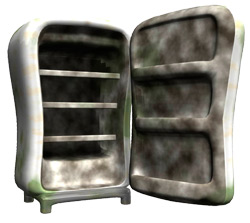 How's Your Fridge Health?
How's Your Fridge Health?
The appearance of the refrigerator doesn't count, but how it functions may be critical if you store animal health products in it.
Believe it or not, your refrigerator could be one of the most important aspects of your animal health program. If you have more than one refrigerator, my guess is that your newer refrigerator is in your kitchen, while the older one is in the garage, mud room, porch, tack room, barn, etc. The one in your kitchen may have $75 worth of food, while the old clunker in the barn may have several hundred dollars of animal health products. The appearance of the refrigerator where you keep your animal health products is not important, but how it functions may be critical to your animal health program.
Refrigeration is required for most animal health products (i.e., pharmaceuticals, vaccines). These products should be stored according to the label directions, but generally, these products are labeled to be stored between 35° and 45° F (2° to 7° C). If a product is not stored properly, there is a good chance that it will not be as efficacious as it should be, or may not work at all. Freezing is particularly detrimental to some products and can cause separation of their components.
| Table 1: Temperature of refrigerators containing animal health products | ||
% of readings within the acceptable range of 35° to 45° Fa |
No. of Refrigerators |
|
>95% |
51 (27%) |
|
66%-95% |
38 (20%) |
|
36%-65% |
34 (18%) |
|
5%-35% |
23 (12%) |
|
<5% |
45 (24%) |
|
| a288 data points were recorded over a 48-hour period for each of 191 refrigerators. | ||
A survey of temperature ranges found in animal health product refrigerators was recently conducted by University of Arkansas researchers. They surveyed 191 refrigerators on farms (76%), retail stores (18%), and veterinary clinics (6%). Data loggers were used to record the temperature at 10-minute intervals for 48 hours. The results are shown in Table 1. Only 27% of the refrigerators tested reliably kept the temperature between 35° and 45° F, meaning that more than seven of 10 refrigerators were unacceptable in keeping the proper temperature.
Following are best management practices (BMPs) for maintaining proper storage of your animal health products.
Refrigerator placement. Good air circulation around the refrigerator is essential for proper heat exchange and cooling functions. The unit should be placed in a well-ventilated room and should have space around the sides and top. Whether or not the unit has coils on the back, there should be at least 4 inches (in.) of space between the back and the wall for proper air circulation. The unit should stand firmly and level, and the wheels or leveling legs should be adjusted so that the bottom sits 1 to 2 in. above the floor. It is a good practice to post a "Do Not Unplug" sign next to the refrigerator's electrical outlet to reduce the risk of accidental power loss. Posting a sign is standard practice in medical clinics, but may be even more important in the farm shop, where an outlet may get "borrowed."
Temperature monitoring. Refrigerator and freezer thermostats are marked in various ways, but, in general, thermostats show levels of coldness rather than temperature. The only way to know the temperature inside the unit is to measure it with a calibrated thermometer. Thermometers designed for accurately reflecting the temperature of a refrigerator generally have a fluid-filled bulb or bottle. If temperature fluctuations are a concern, "min-max" thermometers are available that record low and high temperatures.
The thermometer should be placed in the center of the compartment away from the coils, walls, floor and fan in order to obtain a true reading of the temperature. In the refrigerator, the thermometer should be placed on the middle shelf, adjacent to the vaccine, or hanging down from the upper shelf. In the freezer, the thermometer should be suspended from the ceiling of the compartment or placed on a box or some other item so that it is in the middle of the compartment off the floor.
Storing animal health products. Store ice packs in the freezer and large jugs of water in the refrigerator along with the animal health products. This will help maintain a stable, cold temperature in case of a power failure or if the refrigerator or freezer doors are opened frequently. Store the water bottles against the inside walls and in the door racks. Store the frozen packs along the walls, back, and bottom of the freezer compartment and inside the racks of the freezer door. Sufficient freezer packs should be stored in preparation for transport or for a power outage. Frequent opening of the refrigerator unit doors can lead to temperature variations inside, which can reduce vaccine efficacy. For this reason, you should not store food or beverages in the refrigerator or freezer. In addition, do not store animal health products in the door shelves. These shelves are subject to greater temperature fluctuation than the main compartment.
Editor's Note: This article is reprinted with permission from the Fall 2009 "Cattle Call" newsletter, a publication of the Michigan State University Beef Team.
[Click here to go to the top of the page.]




